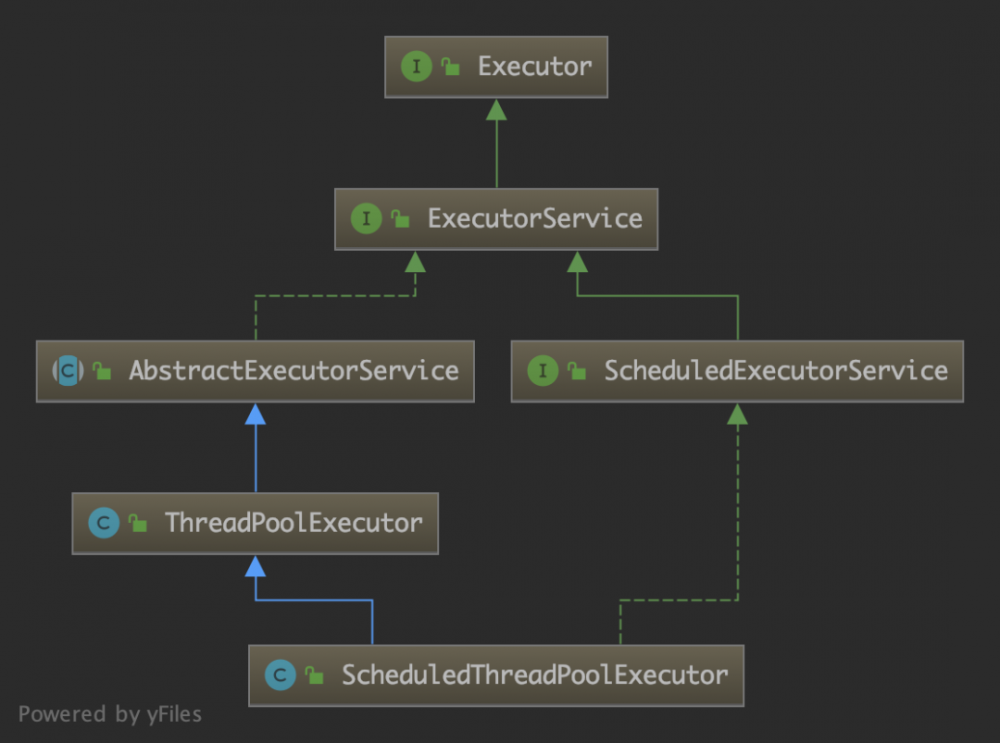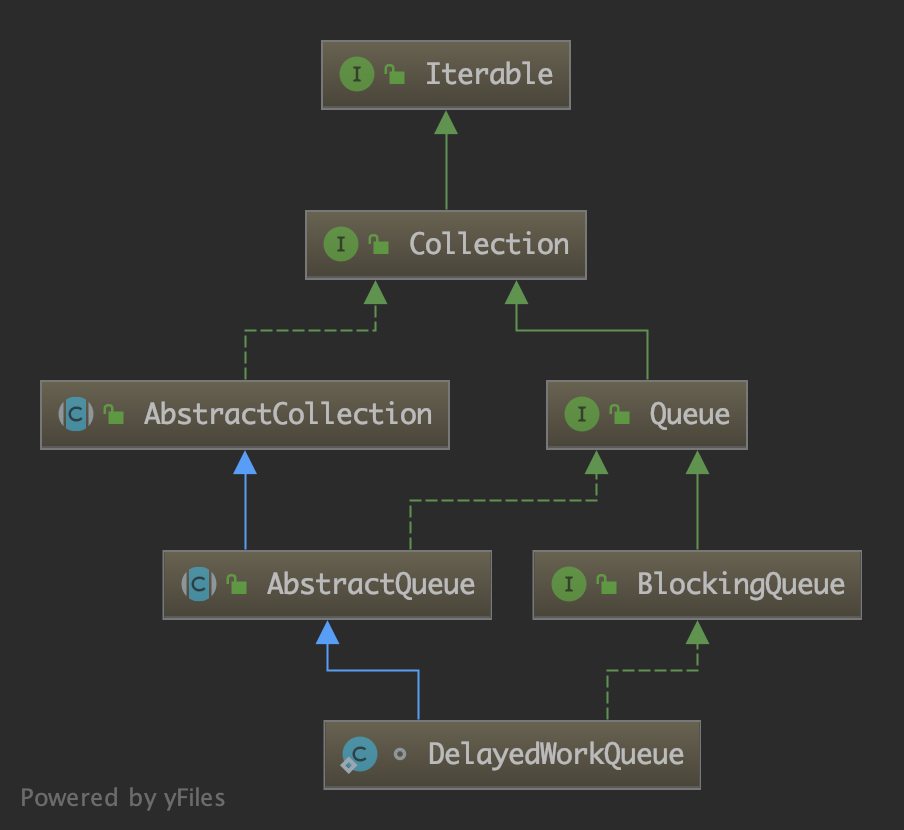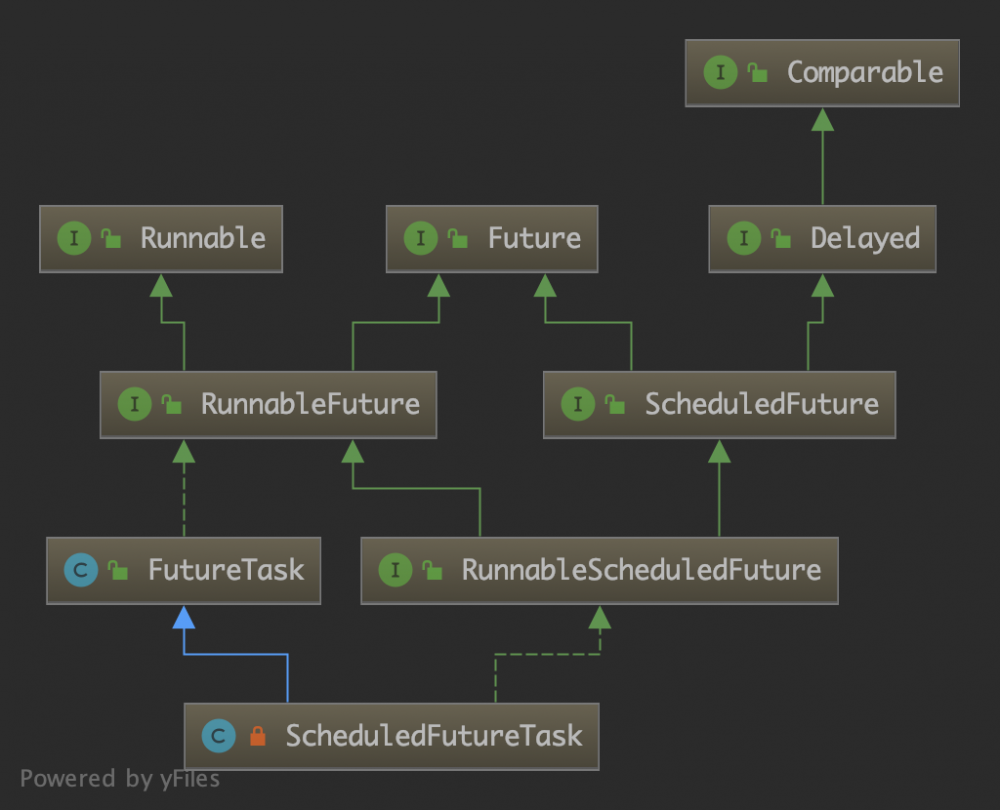JDK 源码分析:ScheduledThreadPoolExecutor
概述
ScheduledThreadPoolExecutor 也是一个线程池类,是线程池类 ThreadPoolExecutor 的子类。 除了 ThreadPoolExecutor 相关的方法之外,它还增加了执行定时任务和周期性任务的方法。它的类 签名和继承结构如下:
<span><span>public</span> <span><span>class</span> <span>ScheduledThreadPoolExecutor</span></span></span>
<span> <span>extends</span> <span>ThreadPoolExecutor</span></span>
<span><span> <span>implements</span> <span>ScheduledExecutorService</span> </span>{}</span>

可以看到,它继承了 ThreadPoolExecutor 类(参考 「 JDK源码分析-ThreadPoolExecutor 」),并且实现了 ScheduledExecutorService 接口(参考 「 JDK源码分析-ScheduledExecutorService 」),因此具有二者的特性。 下面分析其代码实现。
代码分析
内部嵌套类 DelayedWorkQueue
先看它的一个内部嵌套类 DelayedWorkQueue,该类是一个延迟队列,它的类签名和继承结构如下:
static class DelayedWorkQueue extends AbstractQueue<Runnable>
implements BlockingQueue<Runnable> {}

Delay edWorkQue ue 类与前文分析的 DelayQueue 「 JDK源码分析-DelayQueue 」实现原理类似 ,这里就不再赘述。
构造器
ScheduledThreadPoolExecutor 有如下四个构造器:
public ScheduledThreadPoolExecutor(int corePoolSize) {
super(corePoolSize, Integer.MAX_VALUE, 0, NANOSECONDS,
new DelayedWorkQueue());
}
public ScheduledThreadPoolExecutor(int corePoolSize,
ThreadFactory threadFactory) {
super(corePoolSize, Integer.MAX_VALUE, 0, NANOSECONDS,
new DelayedWorkQueue(), threadFactory);
}
public ScheduledThreadPoolExecutor(int corePoolSize,
RejectedExecutionHandler handler) {
super(corePoolSize, Integer.MAX_VALUE, 0, NANOSECONDS,
new DelayedWorkQueue(), handler);
}
public ScheduledThreadPoolExecutor(int corePoolSize,
ThreadFactory threadFactory,
RejectedExecutionHandler handler) {
super(corePoolSize, Integer.MAX_VALUE, 0, NANOSECONDS,
new DelayedWorkQueue(), threadFactory, handler);
}
这几个构造器都是直接调用父类 ThreadPoolExecutor 的构造器,只是传入了不同的参数。而其中的参数 workQueue 都传入了上面的延迟队列 DelayedWorkQueue。
内部类 ScheduledFutureTask
ScheduledThreadPoolExecutor 还有一个内部类 ScheduledFutureTask,它的继承结构如下:

它继承了 FutureTask 类(可参考前文「 JDK源码分析-FutureTask 」的分析),且实现了 RunnableScheduledFuture 接口,该接口定义如下:
public interface RunnableScheduledFuture<V> extends RunnableFuture<V>, ScheduledFuture<V> {
// 一个任务是否周期性执行的,若是则可以重复执行;否则只能运行一次
boolean isPeriodic();
}
RunnableScheduledFuture 只定义了一个方法 isPeriodic,该方法用于判断一个任务是否是周期性执行的。它继承的 Runna bleF utur e 接口在前文 FutureTask 类中已进行分析,而 ScheduledFuture 接口如 下:
public interface ScheduledFuture<V> extends Delayed, Future<V> {
}
它的内部并未定义方法,只是整合了 Delayed 接口和 Future 接口,Delayed 接口前文也已分析,下面分析该类的主要代码。
先看它的主要成员变量:
// 定时任务执行的时间(单位:纳秒)
private long time;
/**
* 重复执行的任务的时间间隔(单位:纳秒)
* 正数表示固定频率(fixed-rate)执行
* 负数表示固定延迟(fixed-delay)执行
* 零表示非重复执行的任务
*/
private final long period;
// reExecutePeriodic 方法中重新排队的任务
RunnableScheduledFuture<V> outerTask = this;
// 延迟队列中的索引位置,便于快速取消
int heapIndex;
构造器:
/**
* 构造器一:用给定的触发时间(纳秒),创建一个一次性任务
*/
ScheduledFutureTask(Runnable r, V result, long ns) {
super(r, result);
this.time = ns;
this.period = 0;
this.sequenceNumber = sequencer.getAndIncrement();
}
/**
* 构造器二:用给定的触发时间和间隔(纳秒),创建一个周期性任务
*/
ScheduledFutureTask(Runnable r, V result, long ns, long period) {
super(r, result);
this.time = ns;
this.period = period;
this.sequenceNumber = sequencer.getAndIncrement();
}
/**
* 构造器三:用给定的触发时间(纳秒),创建一个一次性任务
*/
ScheduledFutureTask(Callable<V> callable, long ns) {
super(callable);
this.time = ns;
this.period = 0;
this.sequenceNumber = sequencer.getAndIncrement();
}
ScheduledFutureTask 有三个构造器,可分为两类:分别是创建一次性任务(一和三)和周期性任务(二)。 其中一和 三还是 Runnable 和 Callable 的区别。
该类是一个任务类,即 Runnable 接口的实现类,因此它最核心的就是 run 方法,如下:
public void run() {
// 是否为周期性任务
boolean periodic = isPeriodic();
// 若任务不能执行,则取消
if (!canRunInCurrentRunState(periodic))
cancel(false);
// 若为非周期性任务
else if (!periodic)
// 若为周期性任务,调用 ScheduledFutureTask 的父类(即 FutureTask)的 run 方法执行
ScheduledFutureTask.super.run();
// 若为周期性任务,调用 ScheduledFutureTask 的父类(即 FutureTask)的 runAndReset 方法执行
else if (ScheduledFutureTask.super.runAndReset()) {
setNextRunTime(); // 设置下一次执行时间
reExecutePeriodic(outerTask); // 周期性执行
}
}
reExecutePeriodic 方法如下:
/**
* 该方法主要是将周期性任务重新排队
* 它的实现与 delayedExecute 方法(后面分析)逻辑有些类似
*/
void reExecutePeriodic(RunnableScheduledFuture<?> task) {
if (canRunInCurrentRunState(true)) {
super.getQueue().add(task);
if (!canRunInCurrentRunState(true) && remove(task))
task.cancel(false);
else
ensurePrestart();
}
}
schedule & scheduleAtFixedRate & scheduleWithFixedDelay
这几个就是执行定时任务和周期性任务的方法,它们是对前文 「 JDK源码分析-ScheduledExecutorService 」接口所定义的方法实现,可参考前文的分析。
schedule 方法 1:其作用是延迟指定的时间后执行任务(即执行定时任务),只会执行一次。
public ScheduledFuture<?> schedule(Runnable command,
long delay,
TimeUnit unit) {
if (command == null || unit == null)
throw new NullPointerException();
// 把用户提交的 Runnable 对象包装为 RunnableScheduledFuture 对象
// decorateTask 方法默认返回第二个参数
// decorateTask 方法的修饰符是 protected,可根据需求自行扩展
RunnableScheduledFuture<?> t = decorateTask(command,
new ScheduledFutureTask<Void>(command, null,
triggerTime(delay, unit)));
// 执行给定的任务
delayedExecute(t);
return t;
}
delayExecute 方法:
/*
* 延迟或周期性任务的主要执行方法。
* 若线程池已关闭,则拒绝该任务(执行拒绝策略);
* 否则将任务添加到工作队列,若有需要启动一个线程去执行。
* 若在添加任务时关闭了线程池,则将其从队列移除并取消该任务
*/
private void delayedExecute(RunnableScheduledFuture<?> task) {
// 若线程池已关闭,则执行拒绝策略
if (isShutdown())
reject(task);
else {
// 将该任务添加到任务队列(即前面的延迟队列)
super.getQueue().add(task);
// 若当前任务无法执行,则将其从队列移除并且取消执行(类似事务的回滚操作)
if (isShutdown() &&
!canRunInCurrentRunState(task.isPeriodic()) &&
remove(task))
task.cancel(false);
// 任务可以执行,若有需要新增线程以执行该任务
else
ensurePrestart();
}
}
schedule 方法 2:
public <V> ScheduledFuture<V> schedule(Callable<V> callable,
long delay,
TimeUnit unit) {
if (callable == null || unit == null)
throw new NullPointerException();
RunnableScheduledFuture<V> t = decorateTask(callable,
new ScheduledFutureTask<V>(callable,
triggerTime(delay, unit)));
delayedExecute(t);
return t;
}
该方法与前者类似,差别在于这里的参数类型是 Callable,前者是 Runnable 类型,其他操作一样。
scheduleAtFixedRate 方法:
<span><span>public</span> ScheduledFuture<?> scheduleAtFixedRate(Runnable command,</span>
<span> <span>long</span> initialDelay,</span>
<span> <span>long</span> period,</span>
<span> TimeUnit unit) {</span>
<span> <span>if</span> (command == <span>null</span> || unit == <span>null</span>)</span>
<span> <span>throw</span> <span>new</span> NullPointerException();</span>
<span> <span>if</span> (period <= <span>0</span>)</span>
<span> <span>throw</span> <span>new</span> IllegalArgumentException();</span>
<span> <span>// 将 Runnable 对象包装为 ScheduledFutureTask 对象</span></span>
<span> ScheduledFutureTask<Void> sft =</span>
<span> <span>new</span> ScheduledFutureTask<Void>(command,</span>
<span> <span>null</span>,</span>
<span> triggerTime(initialDelay, unit),</span>
<span> unit.toNanos(period));</span>
<span> RunnableScheduledFuture<Void> t = decorateTask(command, sft);</span>
<span> sft.outerTask = t;</span>
<span> delayedExecute(t);</span>
<span> <span>return</span> t;</span>
<span>}</span>
该方法与前面的 schedule 方法类似,区别仅在于使用了不同的 ScheduledFutureTask 对象,其他的执行流程几乎一样。
scheduleWithFix edDelay 方法:
<span><span>public</span> ScheduledFuture<?> scheduleWithFixedDelay(Runnable command,</span>
<span> <span>long</span> initialDelay,</span>
<span> <span>long</span> delay,</span>
<span> TimeUnit unit) {</span>
<span> <span>if</span> (command == <span>null</span> || unit == <span>null</span>)</span>
<span> <span>throw</span> <span>new</span> NullPointerException();</span>
<span> <span>if</span> (delay <= <span>0</span>)</span>
<span> <span>throw</span> <span>new</span> IllegalArgumentException();</span>
<span> ScheduledFutureTask<Void> sft =</span>
<span> <span>new</span> ScheduledFutureTask<Void>(command,</span>
<span> <span>null</span>,</span>
<span> triggerTime(initialDelay, unit),</span>
<span> unit.toNanos(-delay));</span>
<span> RunnableScheduledFuture<Void> t = decorateTask(command, sft);</span>
<span> sft.outerTask = t;</span>
<span> delayedExecute(t);</span>
<span> <span>return</span> t;</span>
<span>}</span>
该方法与 scheduleAtFixedRate 方法基本一样,区别仅在于构建 ScheduledFutureTask 对象时参数 period 不同(一正一负,用以区分类型)。
execute & submit 方法
这两个方法是 Executor 接口和 ExecutorService 接口所定义的方法,代码实现如下:
<span><span><span>public</span> <span>void</span> <span>execute</span>(<span>Runnable command</span>)</span> {</span>
<span> schedule(command, <span>0</span>, NANOSECONDS);</span>
<span>}</span>
<span><br /></span>
<span><span>public</span> Future<?> submit(Runnable task) {</span>
<span> <span>return</span> schedule(task, <span>0</span>, NANOSECONDS);</span>
<span>}</span>
它们内部直接调用了 schedule(Runnable) 方法。 另外两个 submit 方法 :
<span><span>public</span> <T> <span>Future<T> <span>submit</span>(<span>Runnable task, T result</span>)</span> {</span>
<span> <span>return</span> schedule(Executors.callable(task, result), <span>0</span>, NANOSECONDS);</span>
<span>}</span>
<span><br /></span>
<span><span>public</span> <T> <span>Future<T> <span>submit</span>(<span>Callable<T> task</span>)</span> {</span>
<span> <span>return</span> schedule(task, <span>0</span>, NANOSECONDS);</span>
<span>}</span>
它们 内 部直接调用了 schedule(Callable) 方法。
小结
1. ScheduledThreadPoolExecutor 是线程池的实现类之一;
2. 它继承自 ThreadPoolExecutor,并实现了 ScheduledExecutorService 接口;
3. 提供了异步提交任务的 execute 方法和 submit 方法;
4. 提 供了执行定时任务的 schedule 方法和周期性任务的 scheduleAtFixedRate/scheduleWithFixedDelay 方法(使用延迟队列实现)。
相关阅读:
JDK源码分析-ThreadPoolExecutor
JDK源码分析-ScheduledExecutorService
JDK源码分析-DelayQueue
JDK源码分析-FutureTask












![[HBLOG]公众号](https://www.liuhaihua.cn/img/qrcode_gzh.jpg)

